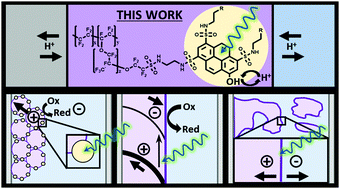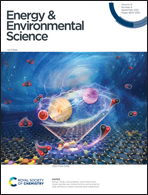Clarification of mechanisms of protonic photovoltaic action initiated by photoexcitation of strong photoacids covalently bound to hydrated Nafion cation-exchange membranes wetted by aqueous electrolytes†
Abstract
Junctions that form at interfaces of electronic semiconductors can lead to space–charge regions, which when properly designed result in diode behavior through current rectification. Space–charge regions are not unique to semiconductor interfaces and also form at ion-exchange-membrane interfaces, with properties that can be tuned by varying the concentration of ions in the contacting phases. Using this as a guide, and motivated by traditional dye-sensitized solar cells, we bathed photoacid-dye-sensitized cation-exchange membranes in aqueous solutions of varied electrolyte concentration and analyzed them for their ability to exhibit photovoltaic action. As predicted by Donnan membrane theory and semiconductor diode theory, the thermodynamic properties of each contacting phase determined the magnitude and sign of the net built-in electric potential difference. Measured open-circuit photovoltages were directly related to these electric potential differences, albeit the sign of the photovoltages was opposite (“reverse”) of that expected based on the sign of net electric potential differences across the membrane. Mechanistic details gleaned using transient absorption spectroscopy indicate that our photoacid dyes only photogenerate protons as the mobile charged species. Because our dye-sensitized cation-exchange membranes were infiltrated with protons, this means that minority-carrier hydroxides were not able to elicit photovoltaic action by standard minority-carrier-dominated effects. Instead, measured photovoltages are consistent with charge separation of a proton from its photoacid conjugate base that is driven by intrinsic liquid-junction-forming crossover of acid, which results in bulk membrane polarization and “reverse” photovoltaic action. These observations inform design guidelines for the use of water as a protonic semiconductor in devices for light-to-ionic power conversion.

- This article is part of the themed collection: Energy & Environmental Science Recent HOT Articles


 Please wait while we load your content...
Please wait while we load your content...
